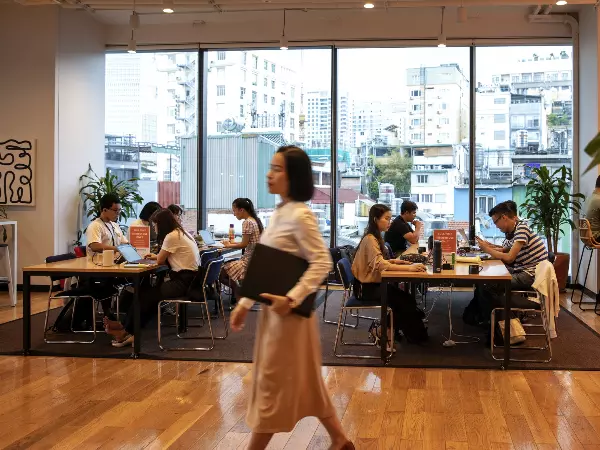What happens on the day of an IPO?
Discover our guide to what an IPO is, what happens on the day of an IPO and the difference between the primary and secondary markets. Learn how to trade once an IPO happens.

What is an IPO?
An IPO, short for initial public offering, is when a private company creates new shares and sells them to the public for the first time. This enables the company to gain access to investor capital, which would be markedly harder if it were to remain private.
The IPO process differs to a direct listing, where a company skips the underwriting process and allows private investors to sell existing shares directly to the market.
The shift from private to public is often an important time for private investors as it usually comes with a share price premium and increased liquidity to offload shares. However, some pre-IPO investors are contractually sealed into a lock-up period, also known as a restriction agreement or escrow, whereby they can’t sell the shares for a length of time after the public launch.1
Companies in Australia seeking to launch an IPO must meet the regulatory requirements imposed by bodies such as the Australian Securities and Investments Commission (ASIC) and the Australian Stock Exchange (ASX).
As part of the pre-launch process, businesses almost always hire an investment bank to do some of the heavy lifting, such as marketing and gauging demand to help set the initial price and launch date.
A short history of IPOs
The first 'modern' IPO occurred in 1602 when the Dutch East India Company offered shares to the public. Over the years, IPOs have faded in and out of popularity, with periods of intense activity usually coinciding with technological innovation or loose monetary policy.2
During the dot-com boom of the early 2000s, there was a surge in IPO activity as tech start-ups sought liquidity. In contrast, the 2008 financial crisis led to a record low in IPO listings, which remained infrequent for several years.
Activity started to roar back with the ultraloose monetary and fiscal policies of the pandemic years, with investors focused on 'unicorns' – companies with a private valuation of more than $1 billion.
As policy has now tightened compared to recent norms, IPO activity may be dampened for some years. However, this also means that companies which do list will receive elevated interest.
What happens on the day of an IPO?
An IPO day occurs over two defined stages.
The primary market
Here, investors who have subscribed to an IPO or registered their interest in the listing receive their allotment of shares before the market opens. The process takes place between the company and these investors through an underwriter – typically an investment bank or stockbroker. Once any lock-up period has passed, these investors are usually free to sell their new holdings just like any other share.
Historically, primary markets were accessible only to institutional investors. Today, many brokers provide retail investors with access to primary markets, allowing them to purchase stock pre-IPO at the listing price.
Note: We do not offer primary market IPO trading
The secondary market
After the primary market concludes (except in the US), shares typically begin trading on the open market on the same day. At this point, shares can be bought and sold freely by members of the public through their stockbroker. Australian and most international shares are available with us to trade immediately.
There is a special case to consider when an IPO involves a general public offer. In this case, investors must wait three days after holding statements have been issued to begin trading on a normal settlement basis. An exception is if a 'conditional and deferred settlement' has been negotiated with the ASX.
There are good but complex risk-based reasons why this happens. But once unconditional trading starts, shares can then be traded freely.
Remember: those who invest in the IPO through the primary market are often subject to a lock-up period. While primary market prices can sometimes be had at a slight discount, investors must weigh this advantage against the common restriction.
What is an IPO price?
An IPO price is the value that the company and its underwriter set for the stock to begin trading on the open market. In Australia, the IPO offer price is normally fixed before the prospectus is lodged with ASIC, either by setting a fixed price or by conducting an upfront 'bookbuild’ of institutional investors.
Secondary market investors should take care to check for price fluctuations before placing a trade. If the opening price is higher than the issue price, it indicates that demand for the shares has increased. This is common when smaller companies conduct an IPO as it sometimes takes the publicity of a listing for analysts to release their opinions.
Factors including demand, industry comparables, growth prospects, finances or even a unique selling point all influence the IPO price on debut. Take, for example, the share price of direct-to-consumer underwear company Step One Clothing Limited (ASX:STP), which surged 76% on its first day of trade in November 2021 to close at $2.70, up from its offer price of $1.53.
On the other hand, shares in liquor and gaming business Endeavour Group Limited (ASX: EDV) fell 6% from $6.50 to $6.10 on the company's first day of trade in June 2021.
Accordingly, many companies choose to slightly underprice their initial shares, as this can tempt investors with a healthy risk appetite to the primary market.
What time do IPOs start trading?
IPOs will start trading at varying times depending on the stock exchange in which the listing is taking place. In Australia, the float or listing time is published on the ASX before the day.²
Elsewhere, as a general rule, UK stocks should become available to retail investors at 7am (UTC) and US stocks at 6.30pm (UTC). However, ubiquitous red tape means that US stocks are often delayed.
Stocks listing on the London Stock Exchange usually reveal their IPO price at 6am (UTC). Timings vary by country – India IPO securities typically begin trading at 4.30am (UTC).
Investors can only access the IPO price in the primary market. Again, you must subscribe to the IPO before the launch to receive your stock allocation.
Although the primary market IPO trading isn’t available with us, you can get exposure to some IPOs after the listing. You’ll do this by trading CFDs on the stock in the secondary market once it’s fully listed. We offer immediate access to the secondary market for most IPOs across Australia, the UK, Europe and Asia. Access to US IPO secondary markets can take several hours, though this is by system design for trading providers like us.
Key market IPO launch times (UTC time)
| Stock Exchange | IPO Start Time |
| Australian Stock Exchange | Various |
| London Stock Exchange (UK) | 7am |
| New York Stock Exchange (US) | 6.30pm, but may take some hours to be tradeable |
| NASDAQ (US) | 6.30pm, but may take some hours to be tradeable |
| Germany | 7am |
| France | 7am |
How to trade or invest in IPOs with us
- Research the company to make sure that it fits with your strategy and goals
- Create your account with us
- After shares are listed, take a position on the secondary market by either buying shares or trading using CFDs
- Open your position
It is important to be aware that CFDs are complex products that may magnify any potential profits and losses, making them a high-risk trading strategy that could potentially result in the loss of more than your initial deposit. Always take steps to manage your risk. When share trading, you buy and own the shares, so you aren't exposed to the risk of leverage.
Frequently asked questions about IPOs
Advantages of an IPO include:
- Access to more capital through the wider investing public
- Increased exposure, public image and prestige
- Increased transparency from quarterly reporting
- Often better borrowing terms from creditors
- Ability to raise additional funds through secondary offerings
Disadvantages of an IPO include:
- IPOs are costly
- Maintaining a public company comes with additional expenses
- Share price fluctuations can distract management from making the best long-term decisions
- Risk-taking managers can feel stifled, especially given the increased paperwork
- Share prices sometimes do not reflect the true value of the company
- Listed companies must disclose business information that may help competitors
- Loss of agency occurs as new shareholders gain rights
What happens on the day of an IPOs summed up
- An IPO is a stock market process by which a private company begins offering shares to the public on a listed exchange in a new issuance for the first time
- Investors can buy shares on the primary or secondary markets, with some marked differences
- Australian IPOs float on the ASX at various times and are published on the ASX website
- The IPO price is the value that the company and its underwriter set for the stock to begin trading on the open market
- Companies benefit from access to more capital at better terms and public exposure, though they must weigh these benefits against increased costs and some loss of agency
IGA, may distribute information/research produced by its respective foreign affiliates within the IG Group of companies pursuant to an arrangement under Regulation 32C of the Financial Advisers Regulations. Where the research is distributed in Singapore to a person who is not an Accredited Investor, Expert Investor or an Institutional Investor, IGA accepts legal responsibility for the contents of the report to such persons only to the extent required by law. Singapore recipients should contact IGA at 6390 5118 for matters arising from, or in connection with the information distributed.
The information/research herein is prepared by IG Asia Pte Ltd (IGA) and its foreign affiliated companies (collectively known as the IG Group) and is intended for general circulation only. It does not take into account the specific investment objectives, financial situation, or particular needs of any particular person. You should take into account your specific investment objectives, financial situation, and particular needs before making a commitment to trade, including seeking advice from an independent financial adviser regarding the suitability of the investment, under a separate engagement, as you deem fit.
Please see important Research Disclaimer.

Explore the markets with our free course
Discover the range of markets you can trade on - and learn how they work - with IG Academy's online course.

